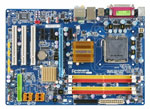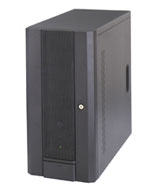Intel Budget Gaming
Traditionally, Intel offerings have tended to be on the more expensive side than configurations from AMD. However, as you shall see, this time the shoe is on the other foot, and we have a very competitive offering from Intel. It's no longer necessary to compromise performance in concession to the almighty dollar, and we are looking at two very strong budget gaming rigs from AMD and Intel.
| Intel Budget Gaming PC |
| Hardware |
Component |
Price |
Rebates |
| Processor |
Intel Core 2 Duo E4500
(2.2GHz 65W Allendale 2MB L2) |
$127 |
- |
| Motherboard |
Gigabyte GA-P35-DS3L
Intel P35 ATX |
$90 |
- |
| Memory |
Crucial Ballistix 2GB (2x1GB) DDR2-800 PC2-6400 |
$90 |
$40 |
| Video Card |
PNY GeForce 8800GT 512MB PCI-e 2.0 HDCP |
$260 |
- |
| Hard Drive |
Samsung SpinPoint T Series HD321KJ
320GB 16MB 7200RPM SATA 3.0GB/s |
$75 |
- |
| Optical Drive |
Samsung 20X DVDRW/DL SH-S202G |
$28 |
- |
| Case |
APEX TU150 Black Steel ATX with 400W |
$59 |
- |
| Display |
Acer 20" AL2016WBbd 5ms Widescreen DVI
(1680 x 1050) |
$200 |
- |
| Speakers |
Logitech X-530 70W RMS 5.1 |
$55 |
- |
| Input |
Logitech LX-710 Laser Black USB |
$55 |
- |
| Operating System |
Microsoft Vista Home Premium OEM |
$112 |
- |
| Bottom Line |
$1151 |
$1111 |
 |
Yes, we know we could have gone with the E6550, but that inches our budget up to nearly $1200 - close enough to our last midrange setup to make the difference rather meaningless. The E4500 clocks in at 2.2GHz and uses the Allendale core with just 2MB of L2 cache, while officially only supporting the older 800MHz Front Side Bus. The Allendale also lacks support for Intel's Virtualization technology, but some users are reporting the G0 stepping includes this. With our requirements, this is a moot point as it is mainly for use in server environments. The E4500 has proven to be a good overclocker and regularly overclocks in excess of 3.2GHz. Strangely, Newegg is listing the E4500 as $2 cheaper than the 2GHz E4400.
 |
With Intel G31/G33 motherboards providing woeful IGP performance compared to offerings from NVIDIA or AMD, how does Intel's enthusiast non-IGP chipset perform? Thankfully, it performs extremely well. Carrying on from the highly successful P965 series, we have the P35 chipset. Seemingly built with overclocking in mind, abit, ASUS, DFI, and Gigabyte have managed to produce a very nice selection of P35 motherboards for gamers. However, for our budget, we are limited to just a couple of options: the abit IP-35E or the Gigabyte GA-P35-DS3L. In the end, we chose the latter, because even though it is at the bottom of the P35-DS3 range from Gigabyte, it has proven to have all the vital features and overclocking ability of its more expensive brethren - and at a very attractive price.
 |
By this time, you may be wondering why we chose not to include an aftermarket CPU heatsink to go along with our CPU choices. For this budget, a $50 solution from Thermalright or Scythe was simply not an option, but with the stock AMD and Intel heatsinks incorporating heatpipe technology, we figured we'd still be good for a decent if not spectacular overclock.
The rest of the components are the same as those found in the AMD budget gaming system, and with AMD's HD 3800 (RV670) series still a couple of weeks away, the 8800 GT was an easy choice. Considering that overclocking will stress the CPU, motherboard, and RAM, it may be a wise investment to upgrade the power supply to something from Seasonic, Corsair, Enermax, or even Antec. Sound cards at this budget are simply an unnecessary luxury, and although a Creative Sound Blaster X-Fi would be an addition to complete our configuration, we're happy with onboard offerings - not to mention those soundcard driver issues we mentioned at the beginning; those were issues with the X-Fi.













63 Comments
View All Comments
JarredWalton - Tuesday, November 13, 2007 - link
Don't forget the display! That adds about $200 if you use the display we selected, so you save a bit of money but get a smaller HDD (1/4 the size), a GPU that's not half as fast as the 8800 GT, and I'd use something other than the ASUS M2A-VM if you're going to have a discrete GPU in there. I'm a bit confused as to whether you were shooting for "budget" or "budget gaming".I try not to repeat stuff on every page, as I assume (possibly incorrectly) that people will read the article as a whole. We do mention the option to get a better PSU on the Intel Gaming page. The reality is, all the good PSUs start at around $60 (PCP&C 360W is $58 shipped). I figure you either get one of the 80% Energy Efficient Certified models, or go with whatever comes with your chosen case.
Hope that clarifies things a bit - we're not saying these systems are the *only* way to go right now, as individual needs will vary. If you're looking at gaming, though, I don't think I'd get anything less than the 8800 GT these days. You can cut corners elsewhere to your hearts content, but there are quite a few titles out that now require a lot of GPU power even at moderate resolutions. (Hellgate: London, for example, is pretty sluggish even on a single 8800 GTX! Same goes for the Crysis demo.)
Crassus - Friday, November 9, 2007 - link
Just as an aside - I remember frequent references to the Anandtech Real Time Pricing (labs.anandtech.com) in the old buyer's guides. That seems to have completely disappeared. I wanted to look up something there and I only get error messages, both in Firefox and IE. Is it me or is it you?phusg - Friday, November 9, 2007 - link
Thanks for the article. Just one grammatical mistake that really grates me:"Even though the Intel system comes in at a lower price" is fine.
"Even though the Intel system is cheaper" is fine.
is not!
Polizei - Friday, November 9, 2007 - link
Bravo, Bravo. I just wanted to say that I greatly appreciate this article. I'm an avid computer enthusiast and have followed Anandtech, HardOCP, and CPU magazine for years. That said, I've never felt it necessary to become involved in the forum thread posting until this article. Far too many websites seem to ignore the fact that stable, overclockable, affordable, and high-performing parts are available if someone needs to go that route. $2,000-$6,000 high-performance gaming systems are often regarded as a must-have for every enthusiast, which limits a great deal of modern society if they so choose to game, watch movies, or just want a faster computer. So again, my hat is off to you guys for finally stepping up and putting together a very good guide for lower-priced rigs that actually don't suck and crash every 5 minutes. Not sure if you follow competitors at all, but Maximum PC Magazine recently did a similar article and it was just atrocious as to how they approached it - http://www.maximumpc.com/article/the_500_pc_build_...">http://www.maximumpc.com/article/the_500_pc_build_...wjl - Friday, November 9, 2007 - link
First: the Intel CPUs mentioned here are not able to support hardware virtualization, which is a major issue for me. You have to get a Core 2 Duo 6xxx for that purpose, and they are still pretty more expensive than AMD's offerings, which all (except the low-end Sempron line) support VT-X (they call it Pacifica).Second: As mentioned here before, considering and testing compatibility with Linux is especially with the low budget model a major issue as well. Integrated Intel graphics would be better in that regard, because they open sourced most of their graphics drivers. For an AMD system, open source drivers will be coming, but at the moment those from nVidia should perform better - and you can select whether you want to use the free nv driver or the unsupported but free (as in beer) proprietary driver from nVidia.
Third: As of today, you should think a bit about the "green" factor. Most of todays CPUs are more than fast enough for any serious work we could throw at them, except maybe video processing. Selecting CPUs like the AMD BE series (with 45W max) or even lower level Intel chips (without virtualization capabilities, as mentioned before) should have been considered. There's also much to think about when it comes to power supplies and so on.
Maybe it's interesting to look at the "Solar PC", built from the guys over at Tom's Hardware in Munich? They ended up with a systems which consumes about 61W when idle - including the monitor! Of course, here Laptops really shine.
With low-cost NAS devices like the IcyBox (or MaPower) available, you could even have thought about thin clients or thin-client-like new offering like the Asus Eee PC (like Asus say, they are selling one each 6 seconds now). For 400$ or 300€, you'll get a neat little machine which can do most of what people want to do with their computers today. Add the same price for a RAID1 NAS, which can be shared within your household, and you'll have the perfect "green" setup.
kind regards,
wjl aka Wolfgang Lonien
(you'll find more thoughts from me on the topic on my pages in the interweb)
Calin - Friday, November 9, 2007 - link
Yes, the 800x480 pixels monitor on an Asus Eee will do great, especially in Windows with its fat themes (XP with default theme, Vista with default theme).Hardware virtualization might be a problem, though I hear it isn't much used for performance reasons.
Low power processors? All the way. By the way, you could get low power from a normal processor by undervolting (and maybe underclocking). Not sure if it's possible on the chosen mainboards.
wjl - Friday, November 9, 2007 - link
Who needs Windows to write a letter or surf the net? I hope that system will be history soon, like the dinosaurs...strikeback03 - Tuesday, November 13, 2007 - link
Considering that the average website these days is designed to target a minimum of 1024x768 resolution, surfing on a smaller screen can be a pain.tomoyo - Friday, November 9, 2007 - link
A gamer would never pick a 5ms TN-Film lcd. Those have a lot of ghosting issues compared to 2ms TN-films.tomoyo - Friday, November 9, 2007 - link
First of all, many components are completely unexplained. Second I dislike a number of the choices, the most major issue being the case/psu. Both case and psu picked are from very low quality makers. These are the types of psus that tend to explode with major load. They should never be recommended to users of anandtech. I'd like to see some more detailed research and explanations that go with a focus on good quality components, rather than trying to keep to some cutrate budget.